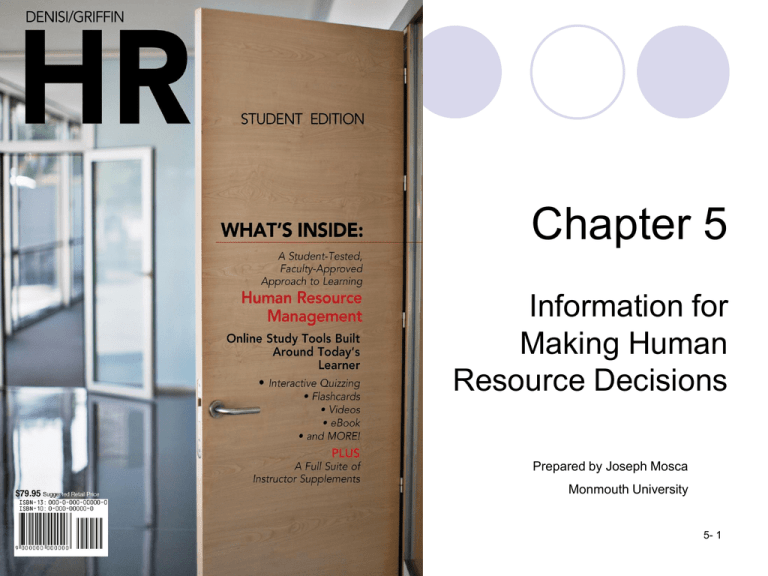
Chapter 5
Information for
Making Human
Resource Decisions
Prepared by Joseph Mosca
Monmouth University
Copyright © 2012 by Cengage Learning. All rights reserved.
5- 1
Learning Objectives
1.
2.
3.
4.
5.
Describe human resource planning as a source of
information for decision making.
Discuss strategy as a source of information for
making human resource decisions.
Discuss economic conditions as a source of
information for making human resource decisions.
Describe job analysis as a source of information
for making human resource decisions.
Discuss the job analysis process and Identify and
summarize common job analysis methods.
Copyright © 2012 by Cengage Learning. All rights reserved.
5- 2
What Is Human Resource Planning?
HR planning is the process of forecasting
the supply and demand for human
resources within an organization and
developing action plans for aligning the
two.
Copyright © 2012 by Cengage Learning. All rights reserved.
5- 3
Information Systems
A human resource
information system is
an integrated and
increasingly automated
system for maintaining
a database regarding
the employees in an
organization.
Copyright © 2012 by Cengage Learning. All rights reserved.
5- 4
Labor Force Trends and Issues
Currently the workforce is diverse in
numerous ways.
The average age of the U. S. workforce is
gradually increasing and will continue to
do so.
Gender differences with more and more
women entering the workforce
Changing ethnicity
Copyright © 2012 by Cengage Learning. All rights reserved.
5- 5
Strategy as a Source of Information
Implications of a growth strategy:
Need to hire new employees
Implications of a stability strategy:
Implement training to upgrade employee skills
Implement programs to help reduce turnover
Implications of a reduction strategy:
Find ways to reduce workforce
Normal attrition processes
Retirement (including early retirement)
Layoffs
Copyright © 2012 by Cengage Learning. All rights reserved.
5- 6
Economic Conditions as a Source of
Information
Rate of unemployment is calculated by the
Bureau of Labor Statistics as the percentage of
individuals looking for and available for work
who are not presently employed.
Market wage rate is the prevailing wage rate for
a given job in a given labor market.
Copyright © 2012 by Cengage Learning. All rights reserved.
5- 7
What Does a Job Analysis Provide?
It provides fundamental input to the HR
manager such as knowledge, skills, and
abilities (KSA) which are the fundamental
requirements necessary to perform a job.
Job families are groups of jobs with
similar task and KSA requirements.
Copyright © 2012 by Cengage Learning. All rights reserved.
5- 8
The Job Analysis Process
Job Analyst: the individual who performs
job analysis in an organization
Subject matter experts (SMEs): An
individual presumed to be highly
knowledgeable about a job and who
provides data for job analysis.
S/he may be an existing job incumbent,
supervisor, or other knowledgeable employee.
Copyright © 2012 by Cengage Learning. All rights reserved.
5- 9
Specific Job Analysis Techniques
Narrative job analysis: the most commonly
used method is to have one or more SMEs
prepare a written narrative or text description of
the job
The Fleishman job-analysis system:
procedure that defines abilities as the enduring
attributes of individuals that account for
differences in performance; it relies on the
taxonomy of abilities that presumably represents
all the dimensions relevant to work
Copyright © 2012 by Cengage Learning. All rights reserved.
5- 10
Specific Job Analysis Techniques
(con’t)
Task Analysis Inventory: a family of job
analysis methods, each with unique
characteristics; each focuses on analyzing all
the tasks performed in the focal job.
Functional job analysis: attempt to have a
single job analysis instrument that can be used
with a wide variety of jobs.
Copyright © 2012 by Cengage Learning. All rights reserved.
5- 11
Specific Job Analysis Techniques
(con’t)
The Position Analysis Questionnaire:
standardized job analysis instrument consisting of
194 items reflecting work behavior, working
conditions, or job characteristics that are assumed
to be generalizable across jobs
Management Position Description Questionnaire
(MPDQ): a standardized job analysis instrument,
similar in approach to the PAQ, which also contains
197 items. The focus is on managerial jobs and the
analysis is done in terms of 13 essential
components of all managerial jobs.
Copyright © 2012 by Cengage Learning. All rights reserved.
5- 12
Specific Job Analysis Techniques
(con’t)
Critical Incidents
Approach: focus is
on critical
behaviors that
distinguish
between effective
and ineffective
performers
Copyright © 2012 by Cengage Learning. All rights reserved.
5- 13
Job Description
A job description lists the tasks, duties,
and responsibilities for a particular job and
specifies the major job elements, provides
examples of job tasks, and provides some
indication of the relative importance of the
effective conduct on the job.
Copyright © 2012 by Cengage Learning. All rights reserved.
5- 14
Job Specification
Job specification
focuses on the
individual who will
perform the job and
indicates the
knowledge, abilities,
skills, and other
characteristics that an
individual must have to
be able to perform the
job.
Copyright © 2012 by Cengage Learning. All rights reserved.
5- 15





